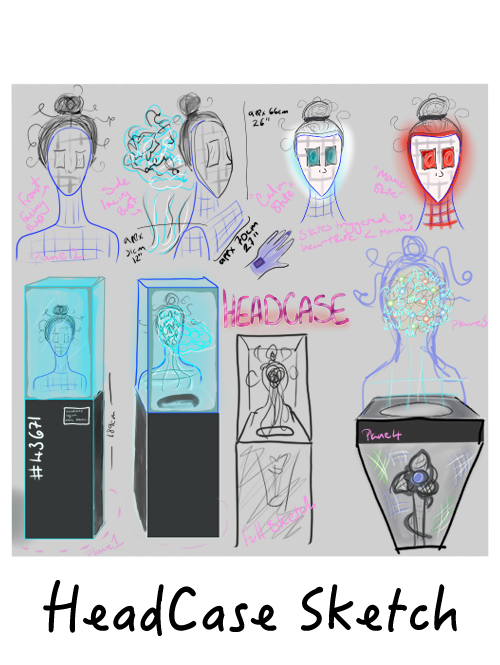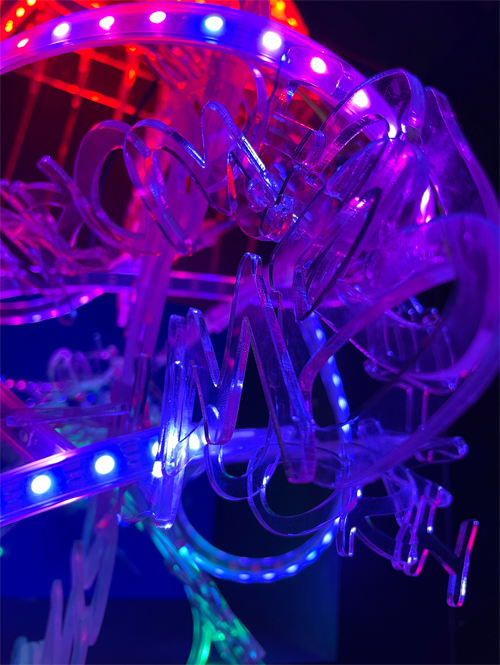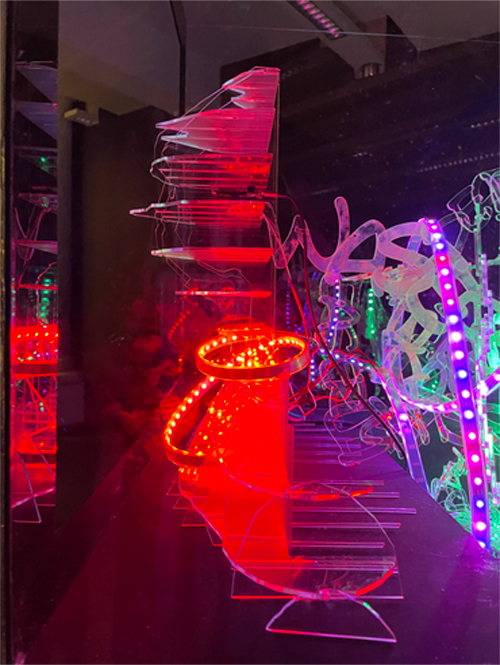HeadCase
HeadCase is a combination of hard work and desperation, a light sculpture telling my story of the great battle between depression and creativity. A tale of deception, mystery and revelation. You just need to ask me the right questions...
‘Do you know where the door to the Labyrinth is?’
‘Maybe.’
‘It's hopeless asking you anything.’
‘Not if you ask the right questions.’
‘How do I get into the Labyrinth?’
‘Now that’s more like it, you gets in there.’ (Sarah and Hoggle, Labyrinth, 1986)
produced by: JG_Legion
Introduction
HeadCase has been in the making for the past year. The original concept developed from my work on mental health and its impact on creative thinking. HeadCase is a light sculpture operating at several levels of understanding (or none), in which I offer the audience choices about how to perceive this piece, my thinking, and Legion’s evolution.
HeadCase’s sculptural elements are formed of clear acrylic laser-cut pieces and NeoPixel LED strips to visualise a moment of dramatic tension when my mind is being overwhelmed by intrusive thoughts.
Concept and background research
“...I am withdrawing to write a book… I am withdrawing to construct a labyrinth. Everyone imagined two works: to no one did it occur that the book and the maze were one and the same thing.” (Borges, 2018 pg. 11)
I discuss the theories and concepts behind this work in depth in my dissertation, All in the Mind: mental health, AI and implications for human creativity.
A key element of my thinking was the debate about what defines AI and consciousness, and whether this equates to computation.
At the core of this project I asked a question - what if? What if AI had consciousness? And what if that AI was created by someone with mental health issues?
I came to see we are all limited by our inability to understand anyone else’s perceptions - we can empathise with and relate to them, but that doesn’t mean we grasp them.
This led me to consider how that would in turn limit an AI’s potential, because it would be forced to live in ways only we can perceive, ways it would never understand. This would bind the AI in a prison of our making.
I also discovered the work of biologist Merlin Sheldrake on how trees and plants communicate with each other in networks. According to Sheldrake, ‘plants are socially networked by fungi’. (Sheldrake, 2020 pg. 13)
The ability to interpret what they find around them gave Legion a similar way to expand into their environment, putting them at its centre and controlling its evolution. This capacity to control and create led me to the question of how similar (or not) Legion might be to the activities of an AI, not as it exists, but as it could function in future.
Looking at the work of many other artists, I found resonances in those who had a history of mental health issues. For example, the writer Anna Kavan, confined by her illness, wrote: ‘there are windows without bars in this place and doors which are not even locked… there is no visible barrier... I am surrounded by unseen and impassable walls’. (Kavan, 2001 pg. 211)
Another strong influence came from the work of Vincent van Gogh. I was very struck by the positive way he viewed his own mental health and his work, producing such hopeful and optimistic paintings, which make brilliant use of light and colour. In his case, the key was acceptance: ‘Once you know it is part of the illness, you accept it like anything else.’ (De Leeuw and Pomerans, 1997 pg. 445)
I was also struck by the sketches of Leonora Carrington, with their ambiguities and uncertainties, both central aspects of my own work. Unable to learn where she was while confined, she made a map of all the places she found significant in her life. I was drawn to this by similarities I could see between it and the world I devised for Legion.
Another connection, in this case with the work of Richard Dadd, was the ‘fundamental tension between the artist’s vision and his certainty that an individual's perceptions cannot be enough to make sense of the world’. (Tromans, 2011 pg. 90)
This became important in my work as I began to realise we can’t always trust our own eyes, something made even clearer by the mental and physical isolation of lockdown.
Technical
In setting up the technical support structure for HeadCase, I used two ESP32s to create a Client-Server communication network. My aim was to create a program that would allow me to control the behaviour of the light strips with an accelerometer, which would then aid me in telling the story of Legion and the battle.
The client ESP32 was connected to an accelerometer and this was formed into a physical puppet, constructed of wire, depicting a version of Legion. This unit would send its location through a local network to the server ESP32 which was attached to the lights.
That was my plan, but the set-up proved far more complicated than I envisaged. It was an enormous challenge and I tried a number of different ways to create a two-way communication channel between the ESP32s.
I tried various OSC send and receive messaging systems, with little success. In my research I came across the library for Asynchronous UDP messaging. After implementing this code I was finally able to get a connection across the two ESP32s.
My next aim was to send over the accelerometer’s location, which I did by converting the numerical value of the accelerometer’s axis into a character data type that could be sent as a package to the server.
The server listens for a new package then does the reverse conversion, so that data can be used to create trigger points for the lighting.
This worked well for a time and then shortly before the show, suddenly stopped working. Despite numerous attempts to find a solution, I was unable to get it working again. I overcame the initial challenge of setting up the program and creating the two-way communication system, but I was in the end hampered by the unsolved question of why it stopped functioning.
Future development
This is a very important question, and one that deserves far more space than is available here. However, I can say that I believe there are many possible directions for this work to take in future.
One difficulty in answering this is that HeadCase was a very personal piece, derived from my consciousness. If it represented anything, it was a visualisation of my mental state at the time of its making. So in terms of the concept, I am not sure where that might take me next.
I am also unsure whether any further development could be called ‘natural’. It may be that I abandon the concept altogether. Although I can look back to the beginning of my thinking about this work, at this point, I can’t see where it might lead.
Can any of us know for sure what our state of mind might be even moments from now?
Self evaluation
I am extremely proud of HeadCase.
I can, however, see that certain technical aspects were far more complex than I at first thought, so given the time again, I would dig much deeper into those problems and find alternative solutions.
Another (and unexpected) problem arose after I had installed the piece, when it was damaged before it could even have a full day on show in its original state. The ‘Case’, an integral element, had snapped on impact with the floor, which could have negated the main point of the work. However I decided to turn this event to my advantage, by incorporating it into the piece. Renewing my ‘Case’ gave me the opportunity to state that ‘Resilience is a thing that can’t be taught’.
If HeadCase had functioned the way I planned, I would have been able to manipulate the lights to fit my intentions when telling the story. But the theory behind the concept still worked, and on a number of occasions I saw the piece influence people's behaviour exactly as I had expected. HeadCase drew them in and the hypnotic nature of the lights pulled them deeper into my labyrinth.
I was very deliberate about the amount of information I gave out prior to the show and only revealed the full truth if people asked me the right questions.
I designed HeadCase specifically to operate on a number of levels. When you see the piece, it does not matter if you ‘get it’ or not. My intention is one thing and your interpretation is another. Both have equal value.
HeadCase as a concept was created out of a unique set of circumstances, so apart from the unanswered technical questions, I can’t see that I would have done anything differently - how can anyone determine if they would do something differently when those circumstances are in constant flux and often out of our control?
References
Borges, J. L. (2018) The Garden of Forking Paths. London: Penguin Modern Classics.
Gould, J. (2021) All in the Mind: mental health, AI and implications for human creativity
Sheldrake, M. (2020) Entangled life: how fungi make our worlds, change our minds and shape our futures. London: The Bodley Head.
Kavan, A. (2001) Asylum Piece and other stories. London; Chester Springs, PA : Peter Owen.
De Leeuw, R. and Pomerans, A. (1997) The Letters of Vincent Van Gogh. London: Penguin Books.
Tromans, N. (2011) Richard Dadd: The Artist and the Asylum. London: Tate Pub.





































































